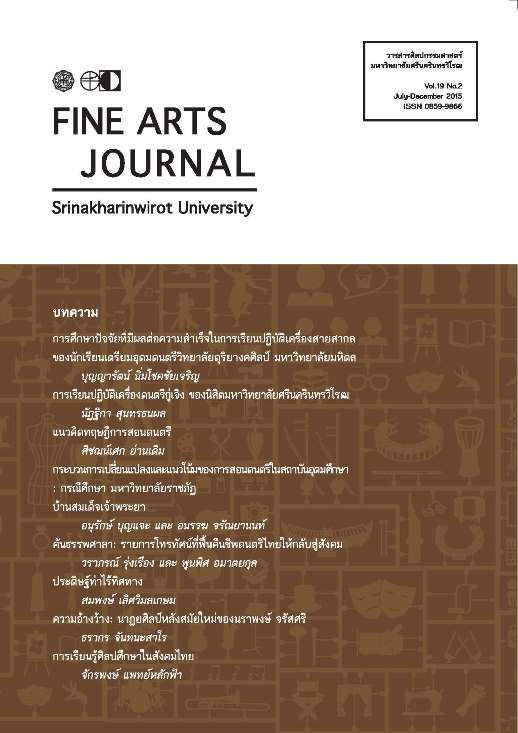CONCEPTUAL THEORY OF MUSIC TEACHING
Keywords:
ดาลโครช, ออร์ฟ, โคดาย, มอนเตสซอรี่, ซูซูกิ, Dalcroze, Orff, Kodály, Montessori, SuzukiAbstract
Investigation through the conceptual theory of music teaching builds recognition of model and biography of the theory, or method, developers. This investigation is practiced with students of five music educators including Dalcroze, Orff, Kodály, Montessori, and Suzuki. Explorations of conceptual theory of music teaching are as follow ings. Dalcroze developed core music learning on Eurhythmic Method and Solfege Methods. Eurhythmic Method is to experience music through body movements to build good rhythmic perception while Solfege Method is to intone fixed tonic (fixed-do) to apprehend pitches together with movements. Orff originally conducted Schulwerk that is like music teaching plan that integrates body movements (like Dalcroze's Method) with pentatonic-note rhythm, Orff's xylophone, rhythmic ostinato and hand signs to music teaching. Kodály principally initiated musical symbols before learning of common music notations. Examples of musical symbols include learning of object images or note stem without note head as prior lesson to the common notation symbols; utilizing hand signals; applying pentatonic-styled folk songs and intoning of moving 'do' from any keys (movable do). Montessori invented three major concepts on musical teaching. Firstly, imitation, students can copy their teacher as a sample prototype. Next, reorganization, students need to recognize and identify differences of tones. Lastly, intonation, students can correctly intone as the final step to understanding and practicing. Suzuki introduced music learning as learning of mother tongue language. The essential of the method is to organize suitable learning ambiences and to arrange everyday practices as a regular activity. The concept is explained that good music practice cannot be acquired from memorizing or text learning. However, it is developed by good and appropriate practice as a part of life or compared as mother tongue language that is utilized every day.






